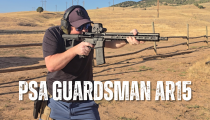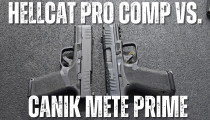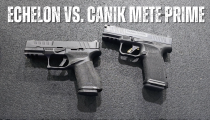Glock 19 vs. Sig Sauer P226 MK25: A Detailed Comparison
When selecting a dependable handgun for self-defense, duty, or range shooting, the Glock 19 and Sig Sauer P226 MK25 frequently dominate the discussion. Both are iconic firearms with dedicated followings, yet they appeal to slightly different preferences and needs. This article compares the two across design, ergonomics, performance, practical applications, and their historical use by the U.S. Navy SEALs to help you decide which pistol suits you best.
Overview
Glock 19: The Glock 19 is a compact, polymer-framed, striker-fired pistol chambered in 9mm Parabellum. Renowned for its simplicity, reliability, and widespread adoption, it’s a top choice for concealed carry, law enforcement, and civilian self-defense. Its lightweight design and minimal controls appeal to shooters who prioritize ease of use and consistency.
Sig Sauer P226 MK25: The P226 MK25 is a full-sized, metal-framed, double-action/single-action (DA/SA) pistol, also chambered in 9mm. Designed for military applications, the MK25 is a variant famously used by the U.S. Navy SEALs, featuring enhanced controls and a rugged build. It’s favored by those who value precision, a refined trigger, and a durable platform.
Design and Build
The Glock 19 features a polymer frame, keeping its weight at approximately 23.6 ounces (unloaded). Its compact dimensions—7.36 inches long, 5.04 inches tall, and 1.38 inches wide—make it ideal for concealed carry or as a backup gun. The steel slide has a durable Tenifer finish, and the pistol sports a utilitarian, squared-off design. The Glock’s Safe Action trigger system incorporates three passive safeties, eliminating external levers.
The Sig P226 MK25, by contrast, is heavier at 34.4 ounces (unloaded) due to its aluminum alloy frame and stainless steel slide. Measuring 7.7 inches long, 5.5 inches tall, and 1.5 inches wide, it’s a full-sized pistol better suited for duty or home defense than concealed carry. The MK25 boasts a corrosion-resistant phosphate finish, an accessory rail, and night sights. Its DA/SA trigger allows a heavy double-action first pull followed by a crisp single-action for subsequent shots.
Ergonomics
The Glock 19’s grip is functional but divisive. Its blocky, one-size-fits-all design (in Gen 4 and earlier models) can feel awkward for shooters with smaller or larger hands, though Gen 5 models offer modular backstraps for improved customization. The slide release and magazine catch are low-profile, aiding concealability but potentially harder to manipulate under stress.
The P226 MK25 excels ergonomically. Its contoured grip, with stippled panels and a slight palm swell, fits various hand sizes comfortably. The decocker, slide release, and magazine release are easily accessible, even with gloves. The MK25’s weight reduces felt recoil, enhancing comfort during extended shooting, though it’s less practical for prolonged carry.
Performance
Both pistols are exceptionally reliable but achieve it differently. The Glock 19’s simplicity—fewer parts and a consistent trigger pull—makes it nearly maintenance-free. It reliably feeds various 9mm ammunition, from budget FMJ to premium hollow points. Accuracy is respectable for a compact pistol, with 3-4 inch groups at 25 yards. The trigger, at around 5.5 pounds, feels spongy to some.
The P226 MK25 is a precision shooter, often achieving 2-3 inch groups at 25 yards. Its longer sight radius and heavier frame enhance accuracy and recoil management. The DA trigger pull is heavy (around 10 pounds), which can affect the first shot, but the SA pull is crisp at 4.4 pounds. Built to handle +P ammo and harsh conditions, the MK25 requires more maintenance than the Glock.
Capacity and Ammunition
The Glock 19 has a standard 15-round magazine but can use higher-capacity Glock magazines (17 or 33 rounds). Its compact grip may cause pinky overhang for larger hands. The 9mm chambering ensures manageable recoil and affordable ammo.
The P226 MK25 also uses 15-round magazines, with 20-round extended options available. Its full-sized grip accommodates all hand sizes. Like the Glock, it’s chambered in 9mm, offering similar recoil and cost benefits, but its heavier frame makes it feel softer-shooting.
Practical Applications
Concealed Carry: The Glock 19 is superior for concealed carry. Its compact size, lighter weight, and slim profile make it easier to hide under clothing. Holster options are plentiful, and its reliability instills confidence in high-stress situations. The consistent trigger pull aids muscle memory.
Duty Use: The P226 MK25 is a standout for duty use. Its accuracy, ergonomics, and robust build make it ideal for law enforcement and military roles. The DA/SA system adds safety for open carry, and the accessory rail supports lights or lasers. Its size and weight, however, make it less practical for all-day carry.
Home Defense: Both are excellent, but the P226 MK25 edges out slightly with its night sights, accessory rail, and superior accuracy. The Glock 19 remains a strong contender for those preferring a lighter, simpler option.
Range Shooting: The MK25 is more enjoyable for range sessions. Its weight reduces recoil, and the SA trigger is ideal for precision. The Glock 19 is fun but feels snappier and less refined.
U.S. Navy SEALs Connection
The Sig Sauer P226 MK25 has a storied history with the U.S. Navy SEALs. Adopted in the late 1980s as the M11 (a compact variant) and later as the full-sized P226, the MK25 became the SEALs’ standard sidearm due to its reliability in harsh environments, including saltwater exposure, and its accuracy. The MK25 variant, with its corrosion-resistant finish and enhanced controls, was specifically tailored for SEAL operations, serving as their primary pistol for decades.
In 2015, the U.S. Navy SEALs began transitioning to the Glock 19 as their standard sidearm, a shift completed by the late 2010s. The Glock 19 was chosen for its lighter weight, simpler operation, and compact size, which better suited the SEALs’ evolving needs for a versatile, concealable pistol in diverse missions. Its reliability, ease of maintenance, and consistent trigger pull aligned with the demands of high-tempo special operations. The Glock 19’s adoption reflects a move toward a more streamlined, modern sidearm, replacing the heavier, more complex P226 MK25.
Maintenance and Durability
The Glock 19 is low-maintenance. Field-stripping is simple, and it can endure thousands of rounds with minimal cleaning. Its polymer frame resists corrosion, and parts are widely available.
The P226 MK25 requires more upkeep. Its metal frame and slide need regular lubrication, especially in harsh environments. Disassembly is slightly more complex, but its durability supports tens of thousands of rounds.
Aftermarket Support
The Glock 19 has an unmatched aftermarket, with endless options for triggers, slides, sights, and holsters. Its popularity ensures affordable upgrades.
The P226 MK25 has solid aftermarket support for holsters, sights, and grips but trails the Glock in variety and cost. Its proprietary rail can limit accessory compatibility.
Price
The Glock 19 retails for $500-$600, offering excellent value. Used models are common and retain value.
The P226 MK25 is pricier, with an MSRP of $1,100-$1,300. Its premium build and SEAL legacy justify the cost for some, but it’s a significant investment.
Conclusion
The Glock 19 and Sig Sauer P226 MK25 are both exceptional, but they serve different purposes. The Glock 19 is ideal for concealed carry, simplicity, and budget-conscious buyers. Its compact size, light weight, and current use by the Navy SEALs highlight its versatility and reliability. The P226 MK25, with its historical significance as the SEALs’ former sidearm, excels for duty, home defense, or range shooting, offering superior accuracy and ergonomics. Its heft and DA/SA trigger may not suit everyone, but its performance is unmatched for a full-sized pistol.
Your choice depends on your needs—whether you prioritize concealability and modern simplicity, as the SEALs now do with the Glock 19, or the precision and legacy of the P226 MK25, trusted by SEALs for decades. Both are reliable, and your intended use, trigger preference, and budget will guide your decision.










